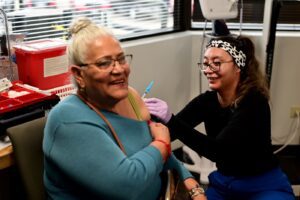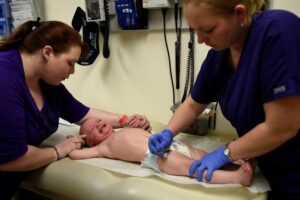Severe cases of COVID-19 are 2.5 times more likely in men with male-pattern baldness than those retaining a full head of hair, researchers have warned.
Male-pattern baldness — or ‘androgenetic alopecia’ — is a common, genetically-determined form of hair loss that affects around 50 per cent of men aged over 50.
It commonly presents as a thinning of the hair in the temporal areas of the scalp before advancing to affect the crown as well.
Researchers found that male patients with a common biomarker linked to hair loss appeared to be significantly more susceptive to severe coronavirus infections.
Specifically, these men were more sensitive to male hormones known as androgens, which is also found in patients with androgenetic alopecia.
The findings of the study may open up new possibilities for new therapies — and possibly even a treatment — for COVID-19, the team said.
Male pattern baldness is controlled by variations in the androgen receptor (AR) gene, which regulates how sensitive the body is to androgens — the so-called ‘male hormones’ that include testosterone and androstenedione.
Androgen responses have also been linked to an enzyme known as TMPRSS2 which is thought to play a role in coronavirus infections.
The researchers were specifically motivated to study the link between the AR gene and severe COVID-19 after observing that a disproportionate number of men with androgenetic alopecia appeared to be being hospitalised with coronavirus.
Specifically, the team reported that some 79 per cent of men with severe COVID-19 had the condition, compared to the 31–53 per cent that would be expected for men of a similar age group.
In their study, the researchers measured the length of the polyglutamine repeat (or CAG repeat) region in the AR gene — which is linked to both androgen sensitivity and male-pattern baldness — in 65 men who had been hospitalised with COVID-19.
They found that the men whose AR CAG repeat was shorter than 22 nucleotides (the molecules than make up DNA) were significantly less likely to be admitted into intensive care with COVID-19 than those patients whose CAG count was 22 or higher.
‘Our data show that longer AR CAG scores are associated with more severe COVID-19 disease,’ said medical researcher Andy Goren of the California-based Applied Biology, Inc.
The findings, he continued, ‘indicate that AR CAG repeat length could be used as a biomarker to help identify male COVID-19 patients most at risk for ICU admissions.’
‘The identification of a biomarker connected with the androgen receptor is another piece of evidence highlighting the important role of androgens in COVID-19 disease severity,’ he concluded.
Dr Goren and his team are also exploring a promising new therapy for COVID-19 patients which uses a so-called androgen receptor antagonist to regulate the expression of TMPRSS2, which may lead to a treatment for coronavirus.
The full findings of the present study will be presented at the European Academy of Dermatology and Venereology (EADV) Spring Symposium 2021, which is being held virtually this year from May 6–7.
‘This research demonstrates the scientific value of dermatology by offering key insights into the role of genetics and its link to COVID disease,’ said EADV board member and Medical University of Warsaw dermatologist Lidia Rudnicka.
‘It is an excellent example of some of the pioneering abstracts being showcased at The EADV Spring Symposium this year,’ she added.





